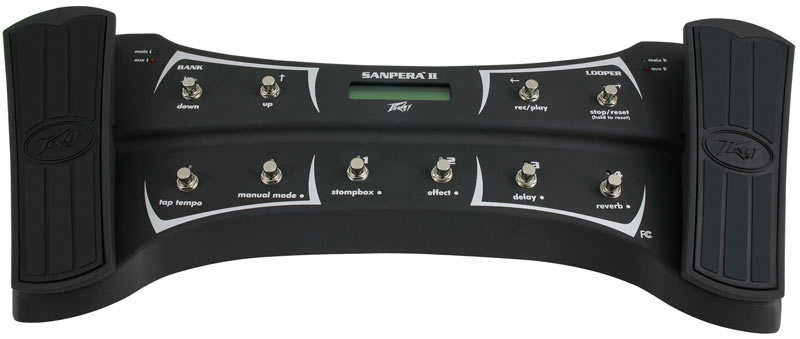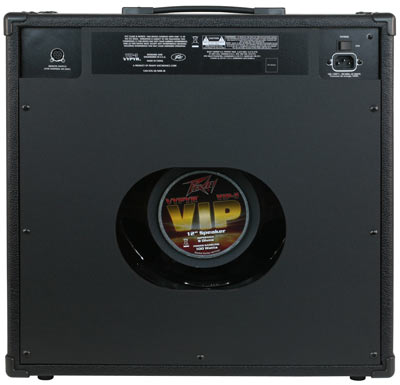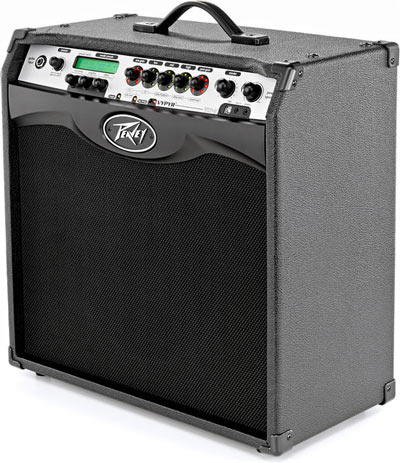Peavey Vypyr VIP 3 Specs
The Peavey Vypyr VIP 3 is an interesting amp packed with a lot of features you might not expect.
Here are the main features of the VIP 3 (check out the price and full features here):
- 100w combo with 12″ speaker (20 & 40w models are available in VIP 1 & 2 range)
- Built-in looper (requires Sanpera foot controller to operate)
- 10 instrument models, 36 amp models, 26 effect models
- Up to 5 effects simultaneously
- LCD screen to select and edit presets (VIP 2 had knobs for all of this)
- Optional Sanpera I & Sanpera II foot controllers (highly recommended)
Here is a list of the Instrument Models available on the VIP 3:
- Acoustic 1: Bright acoustic guitar with a small body
- Acoustic 2: Jumbo dreadnought acoustic guitar with a deep body
- 12 string: Simulation of an electric 12 string guitar
- 7 string: Lowers the pitch by 5 half-steps to simulate a 7 string guitar
- Resonator: Simulation of a Resonator guitar
- Sitar: Simulation of a traditional Indian sitar
- EVIO (monophonic): Electric violin simulation
- Synth (monophonic): Synth instrument simulation
- Baritone: Tunes the instrument down to low A, simulating a Baritone guitar
- Bass (monophonic): Tunes instrument down an entire octave, simulating a Bass guitar
All of the above models allow you to customize specific settings related to that model. For example the 12 string model lets you adjust the body size of the model and the brightness of the strings.
The models EVIO, Synth & Bass are monophonic instruments which are designed to be played one note at a time. To get the best results out of those models you need to adjust your playing style to suit the type of instrument it’s modelling.
Here is a list of the Peavey Vypyr VIP 3 Amp Models:
- British
- Butcher
- Classic
- XXX
- 6534+ (models a Peavey 6505+ head with a EL34 power section)
- 6505+
- Budda
- TWN
- Trace Acoustic
- Peavey Ecoustic
- Trace Bass
- Peavey Bass
As you can see, there are a lot of models available. Each of these models have three different channels which is why the advertising states there are 36 amp models available.
Here’s a nice looking video filled with marketing speak if you want to see the amp (as well as other Vypyr range amps) with fancy lighting:
Ease of use
Guitar, Bass or Acoustic
The VIP 3 has a variable instrument input which means you can plug in an electric guitar, acoustic guitar or bass guitar. When you plug your guitar or bass in to the amp, you need to select what type of instrument it is for the amp to adjust it’s settings to suit. This ensures that the modelling technology matches the type of input you’re using. For example if you plug in an acoustic guitar, the amp needs to know it’s an acoustic to adjust the sound of the instrument models you may use.
Find out about plugging a bass into a guitar amp in this guide. This amp is one of the few that can handle bass or guitar and do a good job at both of them.
Once you choose the instrument you’re using, you can scroll through the different presets using the left presets knob, or you can start creating your own preset.
Editing presets
The VIP 1 & VIP 2 had knobs to control everything from the instrument model, the amp model and the effects. The VIP 3 uses an LCD screen to control the preset and model settings as well as some knobs for basic and advanced features:

While jamming you can tweak the amp settings with the five main knobs, then if you want to edit any of the effects or models, you use the three knobs below the LCD screen to get to the right spot. As you can see there are other indicators for features such as the looper or tap tempo.
Overall there’s a bit of a learning curve as there is with most modelling amps, but once you learn how to navigate the LCD screen, it’s pretty straightforward.
AUX, USB & Headphones
Unlike other amps, you can see that the USB, Aux-in and headphones jack are all conveniently placed on the front face of the amp.
This means you can use your guitar amp as a speaker, which is a handy way to play along with backing tracks or simply listen to music.
This is a welcome change from other amps that tend to place these jacks at the back (I’m looking at you Spider V). The convenient position makes it easy to connect up a smartphone to jam along with or connect to a computer for recording. Unfortunately, it’s not all perfect as the power switch is on the back.
Power sponge
This is a 100w amp which means it’s loud and very powerful. If you’re a bedroom guitarist you might be wondering whether this amp is overkill. The idea with the Power Sponge feature is that you can dial the power of the amp down from 100w all the way to 1w. This means you can set the power to a level that suits the situation.
If you’re jamming at home you can turn it down to 10-20w, turn it up to 30w during band practice or crank it to 100w for outdoor gigs. It’s an interesting feature as 100w is overkill for a lot of guitarists.
The problem with this feature is that it doesn’t work like you might expect. Power does not directly translate to volume. A 50w amp isn’t exactly half the volume of a 100w amp – so turning the Power Sponge down to 50% won’t halve your volume. When testing this feature the change in volume or tone wasn’t as noticable as I expected. This is why a lot of Vypyr owners call the Power Sponge feature a gimmick – it doesn’t have as much of an impact on volume or tone as you might think.
Foot controller
I consider the optional foot controller Sanpera I or Sanpera II as essential when using this amp. If you don’t buy one of those foot controllers, you’re going to miss out on a lot of what this amp can do for you.
You’ll notice that both foot controllers have expression pedals. This means you can easily access wahs, whammy effects, volume control or other effect expression as you see fit. Being able to switch from a wah pedal on one preset to a whammy pitch shifter on another is a great way to explore different effects and tones.
The other big benefit with a foot controller (apart from being able to change presets with your feet) is access to the looper. The looper with this amp can only be accessed with a foot controller so if you want to be able to jam along with some loops, grab yourself one of the foot controllers.
For most guitarists the Sampera I is plenty as it gives you access to all the essential functions you would want.

As you can see the Sampera II gives you more control as well as a second expression pedal so if you’re planning on using this amp for a long time as your main amp, it’s worth considering. Having two expression pedals gives you a lot of control over your sound.
Vypyr Edit Software
While I didn’t get the opportunity to try out the Vypyr Edit software (my student wanted his amp back!), it’s nice to know that you have an alternative to editing your presets by physically adjusting knobs on your amp. Some guitarists prefer this approach as the software often makes it a lot easier to set up and control presets.
If you want to see how the Vypyr Edit software works, here’s a video from Peavey demonstrating how to set it up and use it:
The big downside of the Vypyr software compared to other software such as the Line 6 software is that it’s not as easy to share your presets and settings with other people. Line 6’s apps and software make it really easy to download tones and settings other people have created and quickly load them on your amp. While it’s possible to do this with the Vypyr software, it’s very far behind other amps.
Sound
Presets
As is common with modelling amps, the presets are set up to show off different types of sounds you can achieve. The presets are designed for somebody trying the amp out in the store to skip through them and think “wow this amp can do a lot”. When it comes to actually using your amp and dialing in a really good tone, you’ll find that most presets aren’t that good.
With an amp like the VIP 3, you need to start from scratch to set up a good tone. What I’m trying to say is it’s unfair to judge an amp based on it’s presets. In my review for the Line 6 Spider V, I talk about how shockingly bad some of the presets were. Unfortunately when I started with a blank preset and tried to build up a good tone, I was mostly disappointed with the results.
With the VIP 3 while many of the presets were disappointing, I found it quite easy to set up really good tones when starting from scratch. It was also fairly easy to improve a lot of the presets. For example many of the high-gain presets had too much gain, causing the tone to sound like mush. Turning the gain down added clarity to the tone that significantly improved the preset.
Acoustic amp?
While the VIP 3 is promoted as an acoustic, electric and bass guitar amp, it’s important to note that it’s not perfect at being all three types of amps. There’s a big difference between electric guitar amps and acoustic guitar amps and the VIP 3 isn’t quite an acoustic guitar amp.
Acoustic guitar amps use extra speakers to bring out the higher frequencies you hear in acoustic guitars. The VIP 3 doesn’t have a full range speaker system so it cannot reproduce the same frequency response as an acoustic guitar amp. The acoustic models compensate for this by boosting the higher frequencies, but the 12″ speaker isn’t able to create a perfect recreation of what an acoustic amp would sound like.
It still sounds great, it’s just worth mentioning for guitarists who expect the VIP 3 to perform as well as an acoustic guitar amp. Think of it as an electric guitar amp that let’s you tap into some acoustic sounds.
12 string, 7 string, baritone guitar models
One of the features that grabbed my attention with this amp were the guitar models that change the guitar’s tuning. The 12 string guitar model mixes in a signal one octave higher than your signal to mimic a 12 string guitar. It’s not perfect because it can’t detect what string is played (the B and high E string on 12 string guitars don’t have a doubled string an octave higher), but it still produces a convincing sound.
These models are a great way for guitarists to experiment with different tunings and types of instruments you may not have available. If you’ve ever wondered what a 7 string or a baritone sounds like, these models are great fun to jam with. If you’ve never tuned down to B or A before, you might be surprised with how different it feels to play with.
Of course the sound quality of these models aren’t the same as a real 12 string, 7 string or baritone, but it’s perfectly fine for jamming.
Overall impression of the Peavey Vypyr VIP 3
If you’ve read my review of the Line 6 Spider V, you’ll know I was thoroughly disappointed and frustrated with the entire experience. The features of the amp sounded so promising, so I was really disappointed with bad design choices and questionable sound quality.
I am happy to say that the Vypyr VIP 3 was one of the best combo amps I’ve played. It’s a completely different experience to the Spider V and it gets a lot right. It’s a fantastic amp that is crammed with useful models and effects.
Being able to plug in an electric guitar, acoustic guitar or bass is incredibly handy for guitarists who like to play different styles and instruments. Add on top of that the ability to model other instruments and you have a lot of room to experiment and to be creative.
I highly recommend this amp for beginners or intermediate guitarists looking to upgrade to a more serious amp. If you’re looking for flexibility and want to take your playing further, it’s a fantastic amp.
Check out the price and different options for the Peavey Vypyr VIP 3 here.
Peavey Vypyr VIP 3 Pros
- Able to use with electric guitar, acoustic guitar & bass guitar
- Wide range of instrument, amp and effect models
- Great sound quality
- Extremely versatile
Peavey Vypyr VIP 3 Cons

- Despite the marketing, it’s not a perfect substitute for an acoustic amp or a bass amp
- The power sponge feature isn’t as useful as it sounds
- Definitely need a foot controller to get the most out of the amp
- Looper only available on foot controller
Who is the Peavey Vypyr VIP 3 for?
If you like the idea of being able to experiment with a lot of different instrument models, amp types and effects, this amp is one of the best available. The main benefit this amp offers is flexibility – you can play around with a lot of different tones and effects. If you play the type of music that takes advantage of a lot of different tones and effects, this is a very solid amp choice.
Also, if you have an acoustic guitar or bass guitar, then this amp is definitely worth it as you’ll be able to plug them directly in while keeping the tones intact.
Who isn’t the Peavey Vypyr VIP 3 for?
If you play a style of music that doesn’t use many different effects or you like the idea of having one guitar tone, then this amp probably isn’t what you’re looking for. The main benefit of this amp is the versatility it offers – it can give you a wide range of tones and effects. If you just want to plug in and play around one with one or two tones, then almost all of the amp’s features will be wasted.
Also, if you have no interest in acoustic guitar or bass guitar, the instrument modelling or ability to plug in those instruments won’t be important to you. You would be better off finding a basic amp that has the exact tone you’re after.
How to get the most out of the Peavey Vypyr VIP 3
The Vypyr VIP 3 gives you access to a lot of different amp models, instrument models and effects. The more you learn about how these amps and effects work, the easier it will be to dial in the tones you’re after. As I mentioned earlier, the default presets aren’t set up well so if you want to get the most out of this amp you need to learn how to craft a good tone from scratch.
The Guitar Effects and Tone Course covers all of this in great detail. I go through and show you all common types of effects, how they work and how to get the most out of them. You’ll be able to follow the course using your amp and you’ll see how to set up rigs with multiple effects and tweak your amp for just the right tones.
Alternatives to the Peavey Vypyr VIP 3
At the moment there are quite a few modelling amps, but not many that models instruments or are designed to accept acoustic or bass input. Many of the Line 6 amps are close alternatives to the Vypyr VIP 3. The Line 6 Spider V is a close alternative because it offers a full range speaker system which would be ideal for acoustic guitar as well as electric. It offers a lot of amp and effects models so worth comparing to the Vypyr VIP 3.
I personally feel the VIP 3 is far ahead of the Spider V, but it’s still an alternative some guitarists may prefer.
Useful Resources
As this is a very feature filled amp with a lot of settings you can tweak, the manual contains a lot of helpful information on how to set up your presets. It shows you what all the controls do for various effects, how to access different features and other useful tips.
The manual in the above link also contains information on the VIP 1 & VIP 2 so make sure you read the relevant sections for your amp or you’ll get confused by the different settings and controls.
Note: the useful part of the manual starts at page 21 after all the legal stuff in various languages.
See information on pricing, availability and the different sizes here.


























